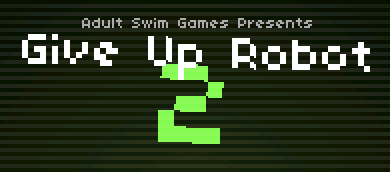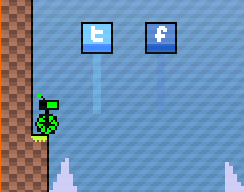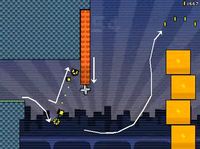Sunday
Dec192010
Give Up Robot 2
 Sunday, December 19, 2010 at 9:29PM
Sunday, December 19, 2010 at 9:29PM Gamasutra posted a best of 2010 top 10 indie games. Many are freeware PC games. So, I'll play as many as I can and analyze their design.

Give Up Robot 2 (GUR2) earned spot number 1 according to Gamasutra. As you may expect the game is good. Play it for yourself here. I beat it in a single sitting in about an hour. From the core mechanics outward, this is a quick analysis.
- MOVE: Left/right. Good amount of air/ground control.
- JUMP: short hop and variable heights beyond the short hop.
- GRAPPLE: Like Gravity Hook, this primary mechanic is highly engaging.
- Dynamic: Players can GRAPPLE onto many surfaces and objects (Bosses, Missiles, elevators, clouds, coins, jet packs, etc)
- Direct: Holding 'Z' extends the hook up to its maximum length. It retracts immediately when 'Z' is released.
- Intuitive: Though the robot swings in an arc and flys off of hooks tangentially to the curve (accurate to real world physics), rotation inertia is not preserved. This simplifies the interactions nicely, but players may have to get used to this arbitrary difference.
- Independent: The 'Z' button is only used to GRAPPLE.
- BOOST: The mid air boost from the jet pack cannot be altered. It only boosts straight up at a set distance/speed and then returns control back to the player. This simplified design gives players a way to rest their minds or gain maneuvering stability to prepare themselves for the next challenge.
Click images to enlarge.
Skills
- The DKART skill that GUR2 stresses the most is timing. There's a bit of internal timing with the purple lazers that switch on-off and the missile launchers. The robot's motion through the 2D space supports organic, external timing skills. At the same time, the majority of timing challenges are very complex. Remember, complex timings are are any elaborate, irregular, and/or layered timings.
- Just when throwing the grapple hook in mid air, there are many different independent layers to the timing action. (see the right image above)
- The robot falling due to gravity.
- The hook traveling away from the Robot as a set speed and angle.
- The ability to maneuver the Robot horizontally in mid air.
- When the hook is latched to a target there's...
- The natural swinging motion that slows to a stop.
- Adjusting the length of grapple line, which changes the speed and size of the rotation arc.
- Influencing the swinging motion horizontally (limited by length of grapple line).
- And finally, depending on the challenge the following factors add to the timing complexity...
- The object the hook is attached to moves.
- The space you must swing through operates on an on/off timer.
- The screen scrolls potentially throwing off spacing relative to the screen versus the game world.
Level Design and Development
- There's a great variety of level elements all used and combined to create 61 unique levels for the normal mode. The levels where new elements are introduced are designed instructively so that players can learn by example and develop important techniques in low pressure situations.

The red line at the end is hidden behind the blue.
Difficulty Design
- The normal game has a nice variety of challenge beyond completing the levels. As far as I can tell, most of the coins are arranged like Super Mario Brothers coins in that all the coins in each level can be collected safely (the cluster of coins in might 54 break this design trend). For a greater challenge players can balance going for coins, getting a low time overall, and having a few deaths as possible.
- The game really sines with the small/single screen levels. The bigger the level, the more the scrolling becomes an issue compounding the difficulty in a way that detracts from the experience. Because the player must travel through long levels to even see what kinds of challenges are hidden off screen, it's more likely that players will die mid way through (especially with no resting place). Some levels are designed so strictly, that once you get to a new section even great reflexes won't be enough to freestyle your way to success. Sure, if you keep trying you'll probably progress, but trial and error is a very inelegant way of going about it.
- The design of the final challenge in the normal mode is exciting, epic, and rough. Though it creates a nice cumulative-set-piece-climax featuring many level elements that you've previously learned, the impact of the final challenge is held back by the ramped up difficulty. Just look at the graph of the time I spent playing (image above). Perhaps the game would be better without such a spike at the end. The steeper the spike, the more frustrating the experience. Of course, some blame falls on me. But, beat the game for yourself and then see how you feel.
- The hard mode is filled with long, scrolling levels. Only getting to level 8 on hard, I appreciate the creative challenges and the skill these levels demand. But this does not excuse the frustrating and disproportionate increase of trial and error.
Genius, Style, and Other Shortcomings
 Twitter/Facebook buttons. The moment I saw these buttons their function was clear. Built into the game's graphical style and core interactions, these buttons were too tempting not to use. I posted my progress on twitter twice because I couldn't resist. If only all indie developers found ways to make spreading the word about their games as fun and seamless as playing.
Twitter/Facebook buttons. The moment I saw these buttons their function was clear. Built into the game's graphical style and core interactions, these buttons were too tempting not to use. I posted my progress on twitter twice because I couldn't resist. If only all indie developers found ways to make spreading the word about their games as fun and seamless as playing.- It's common in platformers with frequent dying and fast restarts to have a stat on how many times you died. I'm always curious to know just how long a particularly tough level held me up. Give Up Robot 2 not only has this stat, but it takes more data and displays it in a graph (see graph above).
- The graphic are a bit rudimentary and remind me of Bullet Time. Chunky particles and other effects help the presentation, but effects like the shaking screen get annoying after a while. At least all the interactive elements are very cleanly drawn.
- The whole Portal style sarcastic-unreliable-harmful narrator idea has been over done in the indie space. The most interesting parts of GUR2's story are the comments (speech bubble and voiced) that objects make when GRAPPLED.
tagged  Platformer in
Platformer in  Difficulty Design,
Difficulty Design,  Level Design,
Level Design,  Mechanics,
Mechanics,  Review,
Review,  Skill |
Skill |  Permalink |
Permalink |  Print Article
Print Article
 Platformer in
Platformer in  Difficulty Design,
Difficulty Design,  Level Design,
Level Design,  Mechanics,
Mechanics,  Review,
Review,  Skill |
Skill |  Permalink |
Permalink |  Print Article
Print Article 


